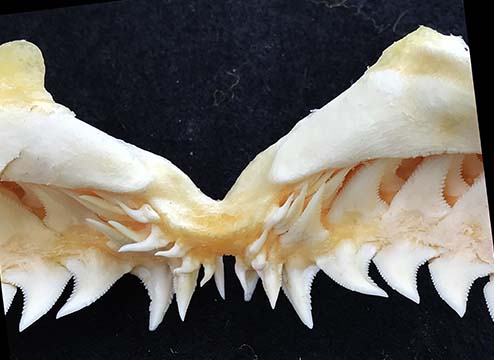BIOLOGY AND RECENT DISTRIBUTION
The “snaggletooth shark” is up to about 8 feet (2.4 m) long, with males being about twice the size of females. It has a blunt snout and a torpedo-shaped body. Its scientific name is Hemipristis elongata (Klunzinger, 1871). This shark is known only from the western Pacific (from China to Australia), the Indian Ocean, and the Red Sea area. It prefers coastal waters and does not occur around oceanic islands.
Figure 1. Shape of the body of a mature Hemipristis elongata individual (modified after alamy.com). The “snaggletooth shark” is appropriately named. It's fearsome teeth are superbly designed to grasp and hold prey. Its serrated teeth are extremely sharp pointed, and some are curved inward and even hook-like. Once this shark bites onto something, it is securely snagged. Also, once its prey (bony fish, other sharks, rays, crabs, or cephalopods) enters the jaws of this shark, there is no backing out. A person has to very careful when handing the jaws of this shark, otherwise painful piercings/hookings can occur.
DENTITION
The following images are all taken of a complete jaw (19 cm [7.75 inches] wide, 16 cm (5.5 inches] high) of a five-foot long (estimated) snaggletooth shark (locality unknown).
Figure 2. Front view of both jaws of a modern specimen of Hemipristis elongata. This upper jaw with biting edge has 28 exposed teeth: 10 left side, 4 left middle area, 4 right middle area, 10 right side). The lower Jaw teeth with biting edge has 28 exposed teeth: 10 left side, 4 left middle area, 4 right middle area, 10 right side. The upper jaw teeth (= the sawing teeth) are curved triangular, except those in the middle part of this jaw, where the teeth are narrower and very pointed (= hook-like gripper teeth). The teeth in the lower jaw are also hook-like gripper teeth.
Figure 3. Back view of both jaws of the same specimen shown in the preceding figure. Notice the numerous rows of stored teeth in the lower jaw waiting to be eventually pushed to the biting edge, as the previous teeth fall out.
Figure 4: Closeup of a portion of the interior of the upper jaw. This view shows the rows of stored teeth ready to be pushed upward to replace any broken or missing teeth along the biting edge. When the stored teeth are pushed upward, they rotate 90 degrees or more.
Figure 5: Oblique view of left side of both jaws. This spectacular view shows how the action of the upper jaw is functionally very different than that of the lower jaw.
Figure 6. Frontal view of the middle teeth on the upper jaw. The teeth on the middle part of the upper jaw are dagger-like to hooklike and have no serrations. The rest of the teeth on this jaw are simitar-like with numerous serrations (used for sawing action) on both sides.
Figure 7. Interior view of the same middle teeth (and laterally adjacent teeth) on the upper jaw. This view is the backside of the part of the jaw shown in Figure 6.
FOSSIL RECORD
The fossil record of Hemipristis ranges from the Eocene to Recent and consists of three species. The only known Eocene species is H. curvatus. It lived during warm times, but when cooler conditions prevailed during the subsequent Oligocene time, this shark genus nearly disappeared. During the warm times of the Miocene, this genus had a large paleogeographic distribution (Maryland to Florida, Belgium, etc.), but it was represented by only one species. H. serra. During the largely cooler times of the Pliocene and Pleistocene, the geographic distribution of Hemipristis once again greatly declined. The only species today is H. elongata, and it is restricted to tropical waters. It is facing extinction if the overfishing by commercial trawlers continues unchecked.
MISCELLANEOUS COMMENTS
As you can readily observe from this post, shark teeth can be very different in shape and size between the upper versus the lower jaw in just a single shark. Now, imagine how challenging it would be for you to identify the type of shark if you have only a single tooth found on the beach or in a fossil bed. How do the experts do it? At some museums, I have seen that shark-tooth experts hang hundreds of preserved shark skulls from the ceiling of their laboratories. That way, they can more quickly match a recently found tooth with known teeth. Another strategy is to have a massive library of computer-stored images showing the different shark teeth for each known genus.
SOURCES OF INFORMATION
www.fossilguy.com
en.wikipedia.org







No comments:
Post a Comment